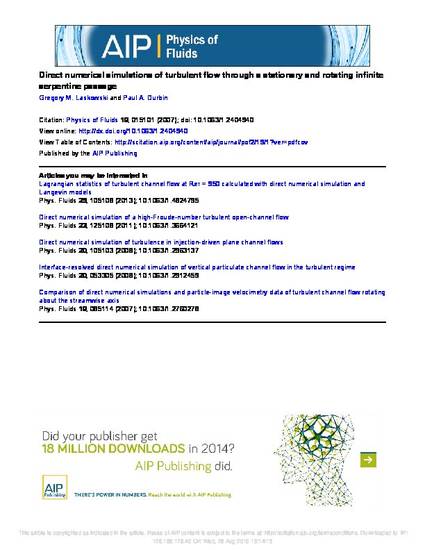
Article
Direct numerical simulations of turbulent flow through a stationary and rotating infinite serpentine passage
Physics of Fluids
Document Type
Article
Disciplines
Publication Version
Published Version
Publication Date
1-1-2007
DOI
10.1063/1.2404940
Abstract
Serpentine passages are found in a number of engineering applications including turbine blade cooling passages. The design of effective cooling passages for high-temperature turbine blades depends in part on the ability to predict heat transfer, thus requiring an accurate representation of the turbulent flow field. These passages are subjected to strong curvature and rotational effects, and the resulting turbulent flow field is fairly complex. An understanding of the flow physics for flows with strong curvature and rotation is required in order to improve the design of turbine blade cooling passages. Experimental measurements of certain turbulence quantities for such configurations can be challenging to obtain, especially near solid surfaces, making the serpentine passage an ideal candidate for a direct numerical simulation (DNS). A DNS study has been conducted to investigate the coupled effect of strong curvature and rotation by simulating turbulent flow through a fully developed, smooth wall, round-ended, isothermal serpentine channel subjected to orthogonal mode rotation. The geometry investigated has an average radius of curvature Rc/δ=2.0 in the curved section and dimensions 12πδ×2δ×3πδ in the streamwise, transverse, and spanwise directions. The computational domain consists of periodic inflow/outflow boundaries, two solid wall boundaries, and periodic boundaries in the spanwise direction. The simulations were conducted for Reynolds number, Reb=5600, and rotation numbers, Rob,z=0 and 0.32. Differences observed between the stationary and rotating cases are discussed in terms of the mean velocity, secondary flow, and Reynolds stresses.
Rights
Copyright 2007 American Institute of Physics. This article may be downloaded for personal use only. Any other use requires prior permission of the author and the American Institute of Physics.
Copyright Owner
American Institute of Physics
Copyright Date
2007
Language
en
File Format
application/pdf
Citation Information
Gregory M. Laskowski and Paul A. Durbin. "Direct numerical simulations of turbulent flow through a stationary and rotating infinite serpentine passage" Physics of Fluids Vol. 19 Iss. 1 (2007) p. article no. 015101 Available at: http://works.bepress.com/paul_durbin/9/

The following article appeared in Physics of Fluids 19, 015101 (2007); and may be found at doi: 10.1063/1.2404940.